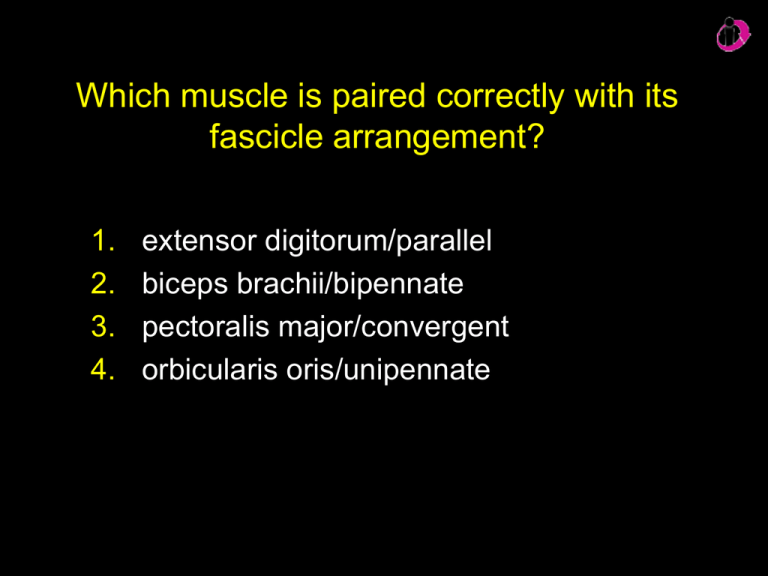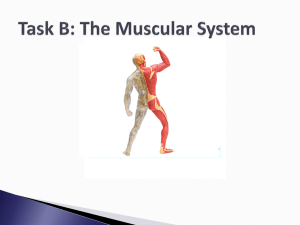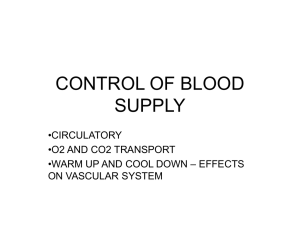Chapter 11
advertisement

Which muscle is paired correctly with its fascicle arrangement? 1. 2. 3. 4. extensor digitorum/parallel biceps brachii/bipennate pectoralis major/convergent orbicularis oris/unipennate A muscle with multipennate fibers would have ___ when compared to a similarly sized muscle with parallel fibers? 1. 2. 3. 4. less range of motion and be weaker the same range of motion, larger fibers, and contract more slowly more fibers, shorten very little, and be more powerful longer fibers, a longer range of motion, and attach obliquely to a central tendon Which type of fascicle arrangement is typical of muscles guarding the opening to the anus and surrounding the eye? 1. 2. 3. 4. convergent muscle multipennate muscle parallel muscle circular muscle (sphincter) The joint between the occipital bone of the skull and the first cervical vertebra (atlas) is part of which type of lever system? 1. 2. 3. 4. first-class lever system second-class lever system third-class lever system fulcrum/load/applied force lever system The benefit of third-class lever systems in muscles is that ___, while the benefit of second-class levers in muscles is ___? 1. 2. 3. 4. they operate at a mechanical advantage/they operate at a mechanical disadvantage speed and distance traveled are increased/a small force can move a heavy weight the fulcrum lies between the applied force and the load/the load lies between the applied force and the fulcrum None of the above Which of the following is true about origins and insertions of skeletal muscles? 1. The fixed end of a muscle is its insertion. 2. The origin is typically distal or lateral to the insertion. 3. During contraction, the insertion moves toward the origin. 4. A muscle with a broad aponeurosis on one end does not have a true origin. Muscle A abducts the humerus, and muscle B adducts the humerus. What is the relationship between these two muscles? 1. 2. 3. 4. synergists antagonists agonists fixators A muscle that assists another in a movement is a ____ and an example is the relationship between the ___ and ___. 1. 2. 3. 4. synergist/latissimus dorsi/teres major antagonist/gracilis/sartorius prime mover/brachioradialis/biceps brachii fixator/gastrocnemius/tibialis anterior What does the name flexor carpi radialis longus tell you about this muscle? 1. 2. 3. 4. its size its action its location 1, 2, and 3 are correct What specific facts can you tell me about the extensor digitorum longus, even if you don’t know the muscle? It is a muscle that….? 1. 2. 3. 4. flexes at a joint, probably moves the elbow joint, and it is short. extends at a joint, probably moves the knee joint, and it is feather-like. extends at a joint, probably moves a finger or toe joint, and it is long. abducts at a joint, probably moves the hip joint, and it is large. Which of these groupings of muscles includes only axial muscles? 1. orbicularis oculi, zygomaticus, trapezius, temporalis 2. masseter, sternocleidomastoid, buccinator, erector spinae 3. quadratus lumborum, scalene muscles, rectus abdominis 4. 2 and 3 are correct If you were contracting and relaxing your masseter muscle, what would you probably be doing? 1. 2. 3. 4. chewing kissing nodding smiling Which facial muscle would you expect to be well developed in a trumpet player? 1. 2. 3. 4. masseter muscle buccinator muscle zygomaticus major and minor orbicularis oris Why can swallowing help alleviate the pressure sensations at the eardrum (tympanic membrane) when you are in an airplane that is changing altitude? 1. It prevents movement of the uvula. 2. It causes a shift in inner ear structures. 3. It moves the eardrum (tympanic membrane). 4. It enlarges the auditory tube opening. Damage to the external intercostal muscles would interfere with what important process? 1. 2. 3. 4. standing upright walking breathing digesting If someone hit you in your rectus abdominis muscle, how would your body position change? 1. 2. 3. 4. You would lean to the right. You would bend backward. You would double over. You would twist to the left. After spending an afternoon carrying heavy boxes from his basement to his attic, Joe complains that the muscles in his back hurt. Which muscle(s) is/are most likely sore? 1. 2. 3. 4. erector spinae muscles latissimus dorsi trapezius Both 1 and 2 Which muscle are you using when you shrug your shoulders? 1. 2. 3. 4. trapezius muscles levator scapulae muscles deltoid muscles sternocleidomastoid muscles The rotator cuff is formed from ___ muscles and is commonly injured by __. 1. 2. 3. 4. rhomboid major and minor, teres major and minor muscles/piano players teres major, teres minor and serratus anterior muscles/golfers rectus femoris, vastus lateralis, vastus intermedius, and vastus medialis/quarterbacks supraspinatus, infraspinatus, subscapularis, and teres minor muscles/baseball pitchers Which two movements would injury to the flexor carpi ulnaris muscle impair? 1. 2. 3. 4. flexion and abduction of the fingers flexion and extension of the wrist flexion and adduction of the wrist flexion and circumduction of the fingers The action of the gluteus maximus muscle is to __ and it has a common insertion with __ at the ___. 1. flexion and medial rotation at the hip/gluteus medius/greater trochanter 2. extension and lateral rotation at the hip/tensor fasciae latae/iliotibial tract 3. adduction at the thigh/adductor magnus/linea aspera of the femur 4. None of these Which thigh movement would be impaired by injury to the obturator muscle? 1. 2. 3. 4. flexion at the hip adduction at the hip medial rotation at the hip lateral rotation at the hip Athletes occasionally suffer a “pulled hamstring”. This phrase refers to damage to which muscles? 1. 2. 3. 4. biceps femoris, gracilis, and adductor magnus rectus femoris, vastus lateralis and vastus medialis sartorius, gracilis and rectus femoris semitendinosus, biceps femoris, and semimembranosus muscle How would a torn calcaneal tendon affect movement of the foot? What muscle(s) is/are the antagonist(s) of the muscles that pull on the calcaneal tendon? 1. 2. 3. 4. no dorsiflexion; tibialis anterior muscle no dorsiflexion; soleus and gastrocnemius muscles no plantar flexion; tibialis anterior muscle no plantar flexion; soleus and gastrocnemius muscles Why is the sternocleidomastoid considered an axial muscle, while the serratus anterior is considered an appendicular muscle? 1. 2. 3. 4. The sternocleidomastoid has both insertions on the axial skeleton and the serratus anterior has its origin on the axial skeleton. The action of the sternocleidomastoid is on the axial skeleton and the action of the serratus anterior is on the appendicular skeleton. The serratus anterior has its insertion on the appendicular skeleton and the sternocleidomastoid’s insertion on the clavicle is not considered. 2 and 3 are correct. One consequence of aging is a decrease in diameter of skeletal muscle fibers. What factors contribute to the decrease in size of muscle fibers? 1. 2. 3. 4. less myoglobin and smaller reserves of glycogen and ATP decreasing elasticity and increasing fibrosis rapid fatigue and decline in thermoregulatory ability decrease in number of satellite cells and a decrease of 30% in aerobic performance







